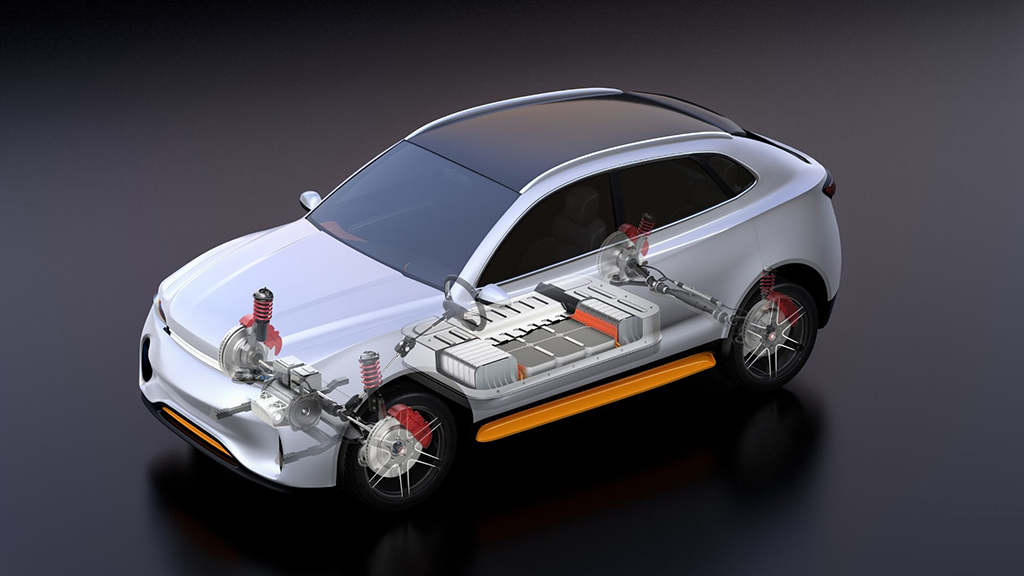Investigating Questions Surrounding Electric Vehicle Batteries
March 17, 2020 | Mariem Zaghdoudi | Education

Electric vehicle (EV) adoption has grown in recent years as drivers look to reduce maintenance costs, enjoy a smoother ride, and reduce greenhouse gas emissions. As the number of EVs on the road rises, questions surrounding them increase as well, particularly on EV batteries. Among some of those EV battery questions are: What are the energy costs of EV battery production and use? Are materials used in EV batteries recyclable? Are battery minerals and metals readily available for safe, ethical, and sustainable mining? Read on as we investigate those questions.
What are the energy costs of EV battery production and use?
Life cycle analysis shows that EVs produce fewer greenhouse gas emissions than internal combustion engine (ICE) vehicles. This analysis assesses the environmental impacts of a product throughout its life, from the extraction of raw materials to final disposal, which accounts for the battery manufacturing process.
While EV manufacturing requires more energy upfront than conventional vehicles because of battery production, EVs travel farther on a given amount of energy and account for fewer emissions during the fuel production and vehicle use phase. Here are some key points on EV battery production and use:
- Compared to ICE vehicles, EVs produce zero emissions during the use phase when operating on the electric motor.
- Evidence suggests that EVs end up only using their original battery[1] since battery degradation is not a typical problem even among EVs with high travel activity.
- Battery manufacturing life-cycle emissions debt is paid off after the first two years or sooner if the EV is charged using renewable energy.
- Accounting for battery production, fuel cycle, and use, EVs still produce much lower greenhouse gas emissions than conventional vehicles, as demonstrated by figure 1.
Figure 1: Lifetime carbon dioxide (CO2) emissions among conventional, electric, and plug-in hybrid vehicles

Figure authored by Elizabeth Abramson, GPI, November 2019, based on a chart that originally appeared in Dale Hall and Nic Lutsey, “Effects of Battery Manufacturing on Electric Vehicle Life-Cycle Greenhouse Gas Emissions” (International Council on Clean Transportation, February 2018), https://theicct.org/sites/default/files/publications/EV-life-cycle-GHG_ICCT-Briefing_09022018_vF.pdf.
While EV emissions overall are already lower compared to conventional vehicles, the emissions associated with EV battery production are declining. Most of the emissions associated with battery production largely depend on the electricity being used by the plant. Considering that electricity is getting cleaner through more efficient power plants and by incorporating renewable energy and lower-carbon energy sources into the grid, the emissions attributed to battery production will continue to decrease over time. Leading analysis by the International Council on Clean Transportation shows that the expected decarbonization of electric grids by 30 percent will further lower battery manufacturing emissions by 17 percent by the year 2030.[2] These findings align with analysis by the Great Plains Institute (GPI, which facilitates Drive Electric Minnesota), where we studied greenhouse gas emissions intensity across different electricity regions and predicted similar reductions in electric grid emissions intensity.[3]
Moreover, lithium-ion batteries retain 75–80 percent of their original capacity after their removal from EVs, meaning that the initial (higher) cost of their production will be spread across more use. This is especially the case if the batteries are reused after being taken out of EVs, as described in studies on the reuse of batteries:
- A study by the International Council on Clean Transportation titled “Effects of Battery Manufacturing on Electric Vehicle Life-Cycle Greenhouse Emissions” identifies stationary storage applications as a reuse opportunity for EV batteries.[4]
- A study by the National Renewable Energy Laboratory titled “Identifying and Overcoming Barriers to Widespread Second Use of PEV Batteries” estimates that the second life of batteries could last up to 10 years. The same study also names replacing grid-connected combustion turbine peaker plants and providing peak-shaving services as the most promising applications of second use batteries.[5]
Are materials used in EV batteries recyclable?
Most materials used in EV battery manufacturing, such as copper and aluminum, are already very widely recycled.[6] Copper, for instance, which makes up 8 percent of the battery cell mass in the Chevrolet Bolt (compared to 2 percent for lithium), is 100 percent recyclable while maintaining its valuable engineering qualities such as durability, high conductivity, and efficiency.
Copper is essential to EV technology and its supporting infrastructure. It is used in EV batteries, charging stations, and supporting infrastructure because of its engineering qualities. While the demand for copper is increasing, copper is a sustainable material that can be used and reused without damaging its engineering qualities.
While lithium is historically more challenging to recycle than copper, an increase in demand for EVs will help to create more demand and spur more research and development for recycling.[7] There is already a company in Canada, Li-Cycle, that can recycle up to 100 percent of lithium from a battery.
Are there strategies that would make mining battery minerals more safe, sustainable, and ethical?
Even though many materials used in EV batteries are already recyclable, some EV manufacturing companies like Tesla are working to improve battery chemistries and are seeking solutions that rely less on mining raw materials.[8] A study by J.B. Dunn in Energy & Environmental Science found that existing cobalt and nickel supplies could be sufficient if manufacturers continue to move away from cobalt and nickel because of their high cost and that lithium supplies are sufficient even if large-scale EV deployment worldwide leads to high demand.[9] Leading EV manufacturer Tesla has been consciously making the move from cobalt to nickel in its use of battery cathodes, on account of the questionable mining conditions surrounding cobalt. Additionally, Apple, which accounts for a quarter of the world’s production of metals for its iPhones and iPads, is moving to buy cobalt directly from mining companies. This move to direct suppliers will give Apple more control over mining conditions.[10] Reducing the need for mining raw materials by recycling metals and moving away from ethically questionable supplies are two strategies that could make mining battery minerals more safe, sustainable, and ethical.
Takeaways
EVs will play an essential role in reducing emissions from the largest source of greenhouse gas emissions—the transportation sector—and transforming the way we move. That role will only increase as the life cycle greenhouse gas emissions continue to decrease, the recyclability of batteries expands, and the increasing awareness of questionable mining conditions leads to better mining practices.
To stay connected to all things EV, like, share, and follow Drive Electric Minnesota at @DriveElectricMN on Facebook and Twitter. Additionally, sign-up for our newsletter here.
[1] Dale Hall and Nic Lutsey, Effects of Battery Manufacturing on Electric Vehicle Life-Cycle Greenhouse Gas Emissions (International Council on Clean Transportation, February 2018), https://theicct.org/sites/default/files/publications/EV-life-cycle-GHG_ICCT-Briefing_09022018_vF.pdf.
[2] Dale Hall and Nic Lutsey, Effects of Battery Manufacturing on Electric Vehicle Life-Cycle Greenhouse Gas Emissions (2018).
[3] Jessi Wyatt and Maggie Kristian, “Electric Sector Emissions: How Geographic Choices Impact Modeling and Analysis,” Great Plains Institute, March 4, 2020, accessed March 6, 2020, https://www.betterenergy.org/blog/electric-sector-emissions-how-geographic-choices-impact-modeling-analysis.
[4] Dale Hall and Nic Lutsey, Effects of Battery Manufacturing on Electric Vehicle Life-Cycle Greenhouse Gas Emissions (2018).
[5] J. Neubauer, K. Smith, E. Wood, and A. Pesaran, National Renewable Energy Laboratory, Identifying and Overcoming Critical Barriers to Widespread Second Use of PEV Batteries (February 2015), https://www.nrel.gov/docs/fy15osti/63332.pdf.
[6] Copper Development Association Inc., Copper Drives Electric Vehicles, accessed March 16, 2020, https://www.copper.org/publications/pub_list/pdf/A6191-ElectricVehicles-Factsheet.pdf.
[7] Jo Dewulf et.al., “Recycling Rechargeable Lithium Ion Batteries: Critical Analysis of Natural Resource Savings,” Resources, Conservation, And Recycling 54, no. 4 (February 2010): 229-234, https://www.sciencedirect.com/science/article/pii/S0921344909001815.
[8] Ernest Sheyder, “Tesla Expects Global Shortage of Electric Vehicle Battery Minerals,” Reuters, May 2, 2019, https://www.reuters.com/article/us-usa-lithium-electric-tesla-exclusive/exclusive-tesla-expects-global-shortage-of-electric-vehicle-battery-minerals-sources-idUSKCN1S81QS.
[9] J.B. Dunn, L.Gaines, J.C. Kelly, C. James, and K.G. Gallagher, “The significance of Li-ion Batteries in electric vehicle life-cycle energy and emissions and recycling’s role in its reduction,” Energy & Environmental Science 1 (January 2015): 158-168, https://pubs.rsc.org/en/content/articlehtml/2014/ee/c4ee03029j.
[10] Jack Farchy and Mark Hurman, “Apple in Talks to Buy Cobalt Directly from Miners,” Bloomberg, February 21, 2018, https://www.bloomberg.com/news/articles/2018-02-21/apple-is-said-to-negotiate-buying-cobalt-direct-from-miners.

Figure authored by Elizabeth Abramson, GPI, November 2019, based on a chart that originally appeared in Dale Hall and Nic Lutsey, “Effects of Battery Manufacturing on Electric Vehicle Life-Cycle Greenhouse Gas Emissions” (International Council on Clean Transportation, February 2018), https://theicct.org/sites/default/files/publications/EV-life-cycle-GHG_ICCT-Briefing_09022018_vF.pdf.
